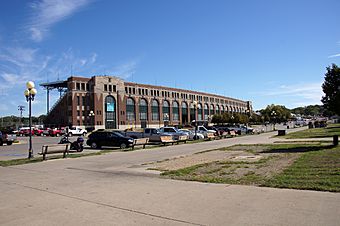Iowa State Fairgrounds facts for kids
Quick facts for kids |
|
|
Iowa State Fair and Exposition Grounds Historic District
|
|

Grandstand
|
|
| Location | East 30th Street and Grand Avenue Des Moines, Iowa, United States |
|---|---|
| Area | 313 acres (127 ha) |
| Architect | Various |
| NRHP reference No. | 87000014 |
| Added to NRHP | September 14, 1987 |
The Iowa State Fairgrounds is a special place in Des Moines, Iowa. Every summer, it hosts the famous Iowa State Fair. The fair started way back in 1854. The fairgrounds we see today were set up in 1886. In 1987, this area was recognized as a historic district called the Iowa State Fair and Exposition Grounds.
Contents
History of the Fairgrounds
The Iowa State Fair did not always stay in one place. When it first began, the fair moved to a different town every two years. The very first fair was held in Fairfield in 1854. Other towns like Muscatine and Iowa City also hosted the fair.
The fair finally moved to Des Moines for good in 1878. At first, it was on the west side of the city. But in 1886, the fairgrounds moved to the east side of town. This land used to be a farm. The original farmhouse and barn from that farm are still on the fairgrounds today!
Early Buildings and Improvements
In 1886, the Iowa Legislature and the city of Des Moines provided money. This allowed the first buildings to be constructed. These early buildings were made of wood. They were built quickly and on a small budget. Because of this, they often needed repairs.
However, these buildings lasted until the early 1900s. Then, they started to be replaced or made bigger. Pioneer Hall is one building from this time that still stands. The streets on the fairgrounds followed the same layout as they do now. But back then, they were dirt roads.
Around 1890, oil lamps were added for street lighting. The next year, 500 electric lights were installed. This made the fairgrounds much brighter at night!
New Buildings in the 1900s
In the early 1900s, new buildings were constructed. These were stronger, made with steel frames and red brick. A new Livestock Pavilion was built in 1902. The Agriculture Building followed in 1904. The Administration Building was completed in 1908.
A new race track and grandstand were built in 1909. The Varied Industries Building was added in 1911. Some of the older wooden buildings were moved and still used. A sewer system was also installed around this time. The streets were still unpaved, but they had curbs. Oil was used to keep the dust down, and cinders were spread to make them more durable.
Fairgrounds in the Mid-1900s
By 1942, the fairgrounds had not changed much. The livestock buildings had been made larger. Running water was installed. Bath and shower houses were built in the campgrounds. Restrooms were added all over the fairgrounds.
Street paving began in the 1930s. Both brick and concrete sidewalks were also added. A storm sewer system was built in 1936. This helped manage rainwater.
After World War II, many new buildings were constructed. Most of these are "pole barn" structures. However, their outsides are still covered in brick. In the 1960s and 1970s, older buildings from around Iowa were moved here. They are now part of Heritage Village. Some of these buildings are even from the fairgrounds' early days in 1886!
The Fairgrounds Today
Today, the fairgrounds cover about 435 acres. About 275 acres are used for the fair itself. The other 160 acres are for camping. The fairgrounds are organized into different areas.
- Animal departments (like cattle, horses, sheep, and poultry) are on the south side.
- Plant departments (like crops, fruits, and flowers) are in the center.
- The fun amusement area, with the midway and race track, is in the northeast.
- The machinery department is in the west.
- The campgrounds are in the east.
The fairgrounds have a main street plan. Grand Avenue, also called the Grand Concourse, runs east to west. Rock Island Avenue runs north to south. The eastern part of the fairgrounds has hills, while the western part is flat.
Besides the yearly state fair, the fairgrounds host many other events. These include auto shows, animal exhibitions, flea markets, antique shows, concerts, and trade shows.
Barns
The fairgrounds have several barns for different animals. These include the Horse Barn, Swine Barn, Sheep Barn, and Cattle Barn.
Varied Industries Building
The Varied Industries Building was first built in 1911. It was originally called the Machinery Hall. In the 1930s, its name changed. It was fully updated in 2001 and is now called the William C. Knapp Varied Industries Building. During the fair, you can see new products and designs here. The second floor displays quilts, rugs, and dolls made in Iowa.
Agriculture Building
The Agriculture Building was built in 1904. During the fair, this is where you can find the famous butter cow!
Heritage Village
Heritage Village is a special section of the fairgrounds. It shows what life was like in Iowa around 1854. This was when the fair first started. You can see things like church hymn sings, a country school, a general store, a barber shop, and a train depot.





